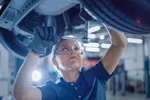The continuing wait for a ruling from Trade and Industry Secretary Stephen Byers on the Competition Commission inquiry findings remains the most destabilising factor in the market.
True, there has been a positive side to this with the retail punter feeling more comfortable to buy a used car rather than a so-called 'rip off' new motor. But equally there are still plenty of people out there who mistakenly believe that the eventual value of their used car is tied up with whatever changes in list price occur.
The big problem, though, is the lack of part-exchanges as new car customers continue to stay away in droves. The absence of 18-month to four-year-old stock has now reached crisis point. It's no surprise - in the past week, I spoke to a major Vauxhall dealer who registered two cars on March 1 and a nearby Volvo dealer who managed four on the W plate.
If the sales figures for the back end of last year - 15% down - looked bad it will be interesting to see those for the past couple of months when they eventually appear. These are certainly strange times for the trade.
Retail activity on used cars did take off at the start of the year and values have not performed badly - especially late-plate stock. Good condition three- year/60,000-mile stock just off lease, in a nice colour and with history, will make proper money.
I was talking to an auctioneer and he reported that there was a real shortage of cars on the block. This, again, is due to the lack of part-exchanges from March 1 because traders would normally be putting them straight into auction for a quick profit. But that will only happen when there is a surplus of part-exchanges.
What has been happening is that either dealers are hanging onto cars they wouldn't normally keep or the trade is putting what it can get hold of straight into main dealers. But the cars that do appear at auction are generally making strong money.
So the main lesson to be drawn from all of this is that the new car crisis offers opportunities elsewhere by exploiting the consumer's confidence that used cars - especially late plates - represent better value for money than new.
The price differential of a late plate car against new list is now, on the face of it, enormous. The irony is that the real gap is not as large as it appears. The incentives available on a new car, such as free insurance and cheap finance add up to a lot. And large over-allowances, which are vital to keep new car sales ticking over, mean owning a new car is cheaper than ever.















Login to comment
Comments
No comments have been made yet.